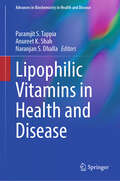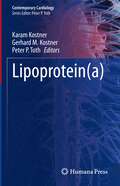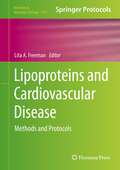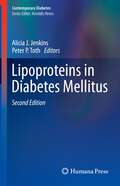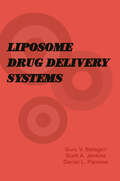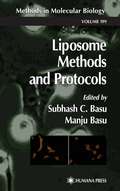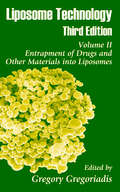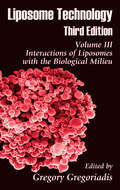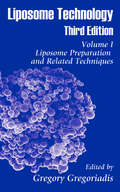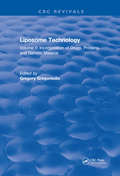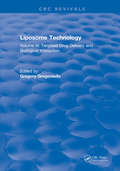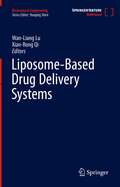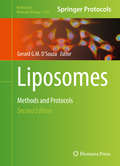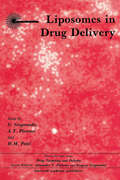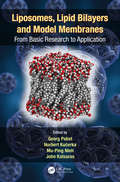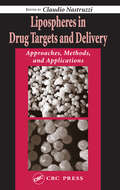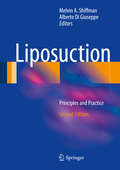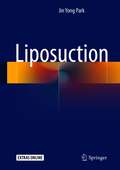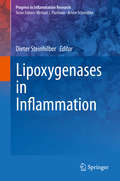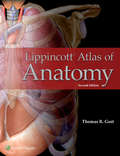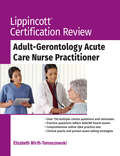- Table View
- List View
Lipophilic Vitamins in Health and Disease (Advances in Biochemistry in Health and Disease #28)
by Naranjan S. Dhalla Paramjit S. Tappia Anureet K. ShahThe concept of “vital amines” as essential nutrients was introduced over a century ago by Dr Casimir Funk. It was suggested that there is a family of organic substances that are required in minute amounts and essential for life. The increase in incorporation of vitamins and supplementation in routine dietary practices is expected to increase. In fact, it has been estimated that 60% of worldwide consumers are taking vitamin supplements on a daily basis, a trend that will most likely rise across the world.This book brings together international experts in the field of vitamins for human health and disease, to update and integrate current understanding on the effects of different lipophilic vitamins on cellular, metabolic and molecular biochemical reactions with respect to different pathophysiological conditions including cardiovascular disease, cancer, metabolic defects, inflammatory and immune diseases. This book is uniquely positioned as it focuses on the biochemistry and molecular biology of lipophilic vitamins in diverse cell systems in relation to human health and disease.The book will certainly stimulate and motivate biomedical researchers and scientists to further explore the relationship between lipophilic vitamins and biological processes, as well as serve as a highly useful resource for nutritional investigators, health professionals, medical students, fellows, residents and graduate students. We hope that the reader will gain knowledge and further understanding of the importance of lipophilic vitamins. The novel insights provided by the contributing authors will assist in advancing preventive medicine worldwide as well as bring forward knowledge that may help in the use of lipophilic vitamins as adjuvant to therapeutic strategies for human disease.
Lipoprotein (Contemporary Cardiology)
by Peter P. Toth Karam Kostner Gerhard M. KostnerLipoprotein(a) [Lp(a)] is a unique lipoprotein that has emerged as an independent risk factor for cardiovascular vascular disease. Data from case control, epigenetic and mendelian randomization studies indicate that people with elevated Lp(a) have a two-fold to four-fold increased risk of cardiovascular events compared to people with low Lp(a) levels. Despite this risk, awareness of Lp(a) is still very low among health care providers. Even cardiologists often overlook Lp(a), in part because Lp(a) is not as well-understood as other risk factors and treatment options are still very limited. This book offers an authoritative and comprehensive overview of Lipoprotein(a). It provides an in-depth review of all aspects of Lp(a), from pathophysiology to metabolism. Chapters offer the reader a contemporary view of the important roles of Lp(a) as a risk factor for cardiovascular disease. In addition, this volume discusses the clinical implications of elevated Lp(a) and current and future therapies. Lipoprotein(a) is an essential resource for physicians, medical students, residents, fellows, and allied health professionals in lipidology, cardiology, endocrinology, pharmacotherapy, and health promotion and disease prevention.
Lipoproteins and Cardiovascular Disease: Methods and Protocols
by Lita A. FreemanThe lipid-rich and otherwise challenging nature of many key tissues complicates many aspects of current research, and applications of the unique nature of lipoproteins and their biological effects has engendered unique and vital methodologies. In Lipoproteins and Cardiovascular Disease: Methods and Protocols, experts in the field present a compendium of advanced and classical molecular biology methods targeted towards lipoprotein, atherosclerosis, and vascular biology research, bringing together in a single volume an updated set of protocols and strategies for methods now driving the most recent advances, along with classical methods that are still widely used. Among the many topics covered in this cutting-edge work, the book delves into crucial techniques such as quantitative real-time PCR, microarrays, RT-PCR laser capture microdissection, and tissue-specific gene overexpression, knockout, and knockdown methodologies, including AAV as a liver-directed gene delivery vehicle. Written in the highly successful Methods in Molecular BiologyTM series format, chapters include introductions to their respective subjects, lists of the necessary materials and reagents, step-by-step, readily reproducible laboratory protocols, and valuable notes which highlight tips on troubleshooting and avoiding known pitfalls. Comprehensive and easy to use, Lipoproteins and Cardiovascular Disease: Methods and Protocols serves both novices and experts alike as a complete guide for any researcher with an interest in lipoproteins and their significant biological effects.
Lipoproteins in Diabetes Mellitus
by Peter P. Toth Alicia J. Jenkins Timothy J. LyonsDiabetes mellitus has become epidemic on a global scale, and millions of new cases are diagnosed every year. The epidemic of diabetes mellitus is expected to result in one of the steepest rises in human morbidity and mortality ever observed outside of wartime. Insulin resistance is a hallmark of pre-diabetes and type 2 diabetes mellitus, and is characterized by impaired insulin-signaling transduction. Authoritative and comprehensive, Lipoproteins in Diabetes Mellitusdetails the many changes wrought by insulin resistance and diabetes mellitus on lipid and lipoprotein metabolism. The book begins by summarizing the various techniques to measure lipoproteins and their subclasses. The mechanisms by which insulin resistance and diabetes mellitus increase risk for atherosclerosis, diabetic retinopathy, and diabetic nephropathy are then explored in detail. Finally, the effects of lifestyle modification and the results of clinical trials using established and investigational drugs are discussed. An invaluable contribution to the literature, Lipoproteins in Diabetes Mellitusis a comprehensive reference on the clinical and scientific aspects of lipoproteins in diabetes. It will have a long-lasting and significant effect on the medical management of people with diabetes.
Lipoproteins in Diabetes Mellitus (Contemporary Diabetes)
by Peter P. Toth Alicia J. JenkinsDiabetes mellitus has become epidemic on a global scale, and millions of new cases are diagnosed every year. With an estimated 80% of people with diabetes living in disadvantaged regions, and the key roles of lipoproteins in the pathogenesis of the chronic complications of diabetes, this volume will be relevant to many readers globally. It is our intention that the contents will advance knowledge of the readers who will use it to contribute to the reduction of the burden associated with altered lipoproteins in people with diabetes. The second edition of this book provides an updated and comprehensive review of the field. The book, which includes many tables and figures, is presented in three main sections: (i) Lipoprotein metabolism, qualitative changes and measurements; (ii) Lipoproteins and the complications of diabetes; and (iii) the treatment of lipoproteins in diabetes. Each chapter from the first edition has been updated, and new topics added. New topics include the links between glycemia and lipoproteins, the role of lipoproteins in ischemic stroke, the diagnosis and management of statin intolerance (which is thought to be more common in people with diabetes) and the use of PCSK9 inhibitors and fish oils in the management of lipoproteins in people with diabetes. This book is written by an international group of experts in the clinical, laboratory and research aspects of lipoproteins in diabetes. Lipoproteins in Diabetes Mellitus, 2nd Edition is a comprehensive reference on the clinical and scientific aspects of lipoproteins in diabetes. It is a must-have resource for primary care and specialist clinicians, clinical and basic science researchers and to trainees and students.
Liposome Drug Delivery Systems
by Guru V. Betageri Scott Allen Jenkins Daniel ParsonsGuide to current liposome drug delivery technology. Applications, preparation, pharmacokinetics, stability, passive and active targeting, and industrial production. Special emphasis on "stealth" liposomes (liposomes with extended circulation times).
Liposome Methods and Protocols
by Subhash C. Basu Manju BasuA panel of skilled researchers describes in step-by-step detail their best laboratory techniques for elucidating liposome biology. With these readily reproducible methods, investigators can illuminate such critical questions as the attachment of liposmes to cell surfaces, the permeation of liposomes through the plasma membranes, and the stability of liposomes in cellular and nuclear matrices. Each detailed protocol is presented by an investigator who is intimately familiar with its problems and capabilities, and includes a detailed list of materials to be used, troubleshooting tips straight from the benchtop, and notes on pitfalls to avoid.
Liposome Technology: Entrapment of Drugs and Other Materials into Liposomes
by Gregory GregoriadisLiposome Technology, Volume II: Entrapment of Drugs and Other Materials into Liposomes, Third Edition is a comprehensively updated and expanded new edition of a classic text in the field. Including step-by-step technical details, Volume II describes procedures for the incorporation of drugs and other materials into liposomes for a variety therapeut
Liposome Technology: Interactions of Liposomes with the Biological Milieu
by Gregory GregoriadisLiposome Technology, Volume III: Interactions of Liposomes with the Biological Milieu, Third Edition, is a comprehensively updated and expanded new edition of a classic text in the field. Including step-by-step technical details, Volume III describes technologies for yielding liposomes that can function in a targeted fashion, and highlights methods
Liposome Technology: Liposome Preparation and Related Techniques
by Gregory GregoriadisLiposome Technology, Volume I: Liposome Preparation and Related Techniques, Third Edition, is a thoroughly updated and expanded new edition of a classic text in the field. Including step-by-step technical details, Volume I illustrates numerous methods for liposome preparation and auxiliary techniques necessary for the stabilization and characteriza
Liposome Technology: Volume I
by GregoriadisAlthough the role of liposomes in drug targeting has been discussed extensively in several reviews and books, there has been no comprehensive coverage of related methodology. This book constitutes the first attempt to put together all aspects of lipsome technology as applied to medical sciences. Volume I deals directly with methods for the preparation of liposomes and auxiliary techniques.
Liposome Technology: Volume II
by GregoriadisAlthough the role of liposomes in drug targeting has been discussed extensively in several reviews and books, there has been no comprehensive coverage of related methodology. This book constitutes the first attempt to put together all aspects of lipsome technology as applied to medical sciences. Volume II describes procedures for the entrapment of a number of drugs, including genetic material, into selected types of lipsomes.
Liposome Technology: Volume III: Targeted Drug Delivery and Biological Interaction
by GregoriadisAlthough the role of liposomes in drug targeting has been discussed extensively in several reviews and books, there has been no comprehensive coverage of related methodology. This book constitutes the first attempt to put together all aspects of lipsome technology as applied to medical sciences. Volume III is devoted to the growing variety of techniques yielding targeted liposomes and to approaches of studying liposomal behaviour in the biological milieu both in vitro and in vivo.
Liposome-Based Drug Delivery Systems (Biomaterial Engineering)
by Wan-Liang Lu Xian-Rong QiThis volume describes the protocols for fabrication of liposomal drug delivery system, and consists of two parts. The first part emphasizes the basic protocols and concepts for fabrication of drug-loaded liposomes. For new investigators, laying the groundwork is the first step. This part focuses on the fabrication details in liposomes formulations, which are the so-called small tricks while usually not disclosed in mostly published research articles. However, these processing details are crucial for the preparation of liposomes. And the second part focuses on the strategies in modified and/or functionalized liposomes to adapt to pathophysiological environment, as well as their application in treating diseases. As new analytical and synthetic technologies become available, and improved understanding of pathophysiology, various functionalized drug liposomes are developing to fit the requirements of different therapeutic purposes, exhibiting a broad range of applications. Accordingly, the objectives of this part are aimed at deeply unearthing the formulation of drug-loaded liposomes, describing the detailed operation of liposomal formulation, and further demonstrating their potential applications. Therefore, this volume shows the features of experimental report or protocol for proving a guide to scientists, research students, and young investigators in pharmaceutical enterprises.
Liposomes
by Gerard G.M. D'SouzaThis second edition volume expands on the previous edition by discussing classic techniques, as well as new protocols that focus on the preparation of liposomes, lipid characterization, particle size and charge analysis, drug encapsulation, surface modification, stimuli response, and cellular interaction and biodistribution. Written in the highly successful Methods in Molecular Biology series format, chapters include introductions to their respective topics, lists of the necessary materials and reagents, step-by-step, readily reproducible laboratory protocols, and tips on troubleshooting and avoiding known pitfalls.Comprehensive and practical, Liposomes: Methods and Protocols, Second Edition is a valuable resource for graduate students, post-doctoral researchers, and established investigators utilizing lipid-based systems in the fields of cell and molecular biology, drug delivery, and physical chemistry.
Liposomes as Tools in Basic Research and Industry (CRC Press Revivals)
by Jean R. Philippot Francis SchuberThis book is devoted to a broader understanding of liposomes as a versatile tool used in many domains, including basic research and applied technology, focusing on less common applications and recent developments.Over the past few years, new types of liposomes made of nonphospholipid molecules have opened new perspectives in applications. These lipid vesicles, already used in cosmetology, are being manufactured for industrial and agricultural uses. However, "Stealth" liposomes, pH-sensitive liposomes, and cationic liposomes have enlarged and improved the application field of liposomes in clinical research. The book covers these different uses of liposomes with particular attention to new formulations and new applications.
Liposomes in Drug Delivery
by AlexanderT. FlorenceThis book is an outcome of the conference on the liposomes in drug delivery: 21 years held in University of London, in 1990. It covers themes such as novel carrier systems, newer and potential responsive or pulsatile systems, or systems such as liposomes which have a longer pedigree.
Liposomes, Lipid Bilayers and Model Membranes: From Basic Research to Application
by Georg Pabst John Katsaras Mu-Ping Nieh Norbert KuCerkaAs a result of their unique physical properties, biological membrane mimetics, such as liposomes, are used in a broad range of scientific and technological applications. Liposomes, Lipid Bilayers and Model Membranes: From Basic Research to Application describes state-of-the-art research and future directions in the field of membranes, which has evo
Lipospheres in Drug Targets and Delivery: Approaches, Methods, and Applications
by Claudio NastruzziLipospheres in Drug Targets and Delivery: Approaches, Methods, and Applications presents an overview of the most recent applications of lipospheres primarily in the field of medicine, pharmaceutics, and biotechnology. It includes chapters on preparation, characterization, delivery (of peptides, proteins, vaccines, nucleic acids), therapeutic applic
Liposuction
by Melvin A. Shiffman Alberto Di GiuseppeThis superbly illustrated book covers all aspects of liposuction: anatomy, pathology, biochemistry, preoperative care, equipment, the full range of procedures, complications, postoperative care, outcomes, lipedema, and medical legal aspects. Compared with the successful first edition, the text has been extensively updated and many additional chapters included, with particular attention to recently introduced techniques. While new technology helps to improve results, experience, care, and skill on the part of the cosmetic surgeon are essential if optimal results satisfactory to the patient are to be achieved. The contributors to this book have expended much time and effort to present the cosmetic and plastic surgeon with as much information as possible on the techniques and uses of liposuction for the purposes of cosmetic and non-cosmetic surgery. Liposuction: Principles and Practice will be of value for residents and fellows and for practicing and highly experienced surgeons in plastic surgery, cosmetic surgery, general surgery, and other subspecialties.
Liposuction
by Jin Yong ParkThis book provides easy-to-understand descriptions of high-quality liposuction techniques applicable to different parts of the body, including the face, abdomen, breasts, arms, buttocks, thighs, and calves. The coverage also encompasses the liposuction treatment of osmidrosis and fat injection techniques (facial, breast, and stem cell). Drawing on his extensive experience of more than ten thousand cases of liposuction and fat and stem cell transplantation, the author presents important new theoretical perspectives and novel surgical approaches that he has personally developed. These include the MDMP technique (multi-direction, multi-position), which is straightforward to perform and offers significant benefits. All procedures are described step by step, from preparation through to completion. The book is superbly illustrated throughout, with a wealth of informative photographs that will aid the practitioner. It will be of high value for experienced plastic and cosmetic surgeons and also for residents and fellows.
Lipoxygenases in Inflammation
by Dieter SteinhilberOxidation of polyunsaturated fatty acids by lipoxygenases leads to a variety of fatty acid metabolites which play important roles in physiology but also in pathophysiology. Data accumulated during the last decade point to the fact that lipoxygenase metabolites are involved in host defence reactions, cardiovascular system and contribute to the development of inflammatory and allergic diseases, cardiovascular disease and cancer. This PIR volume summarizes the physiological and pathophysiological functions of lipoxygenases.
Lippincott Acute Care Skills for Advanced Nursing Assistants: A Humanistic Approach To Caregiving
by Pamela CarterThis combined text and workbook builds on the basic concepts and skills that the nursing assistant has already mastered. The tasks nursing assistants in advanced settings are expected to perform vary greatly in health care settings across the nation. Even if nursing assistants are not allowed to perform tasks independently, they are often expected to understand the care provided and assistant other members of the health care team. The spirit of “lifelong learning” is at the heart of this text, which has been written in a way to inspire nursing assistants to set goals for career advancement and reach them.
Lippincott Atlas of Anatomy (Point (lippincott Williams And Wilkins) Ser.)
by Thomas R. GestFeaturing more than 800 high-quality, modern images, Lippincott® Atlas of Anatomy is a vibrantly colored regional atlas of human anatomy offering an unprecedented combination of visual aesthetic appeal and anatomical accuracy. A unique art style featuring bright colors, color coding of anatomical elements, judicious use of labeling, and no extraneous text make this book an ideal tool for students. Each plate teaches specific structures and relationships—displayed using artistic techniques such as 'ghosting,' layering, and color coding—providing clear focus on important structures and resulting in easier and faster comprehension. This unique pedagogy, in combination with the beautiful art style, make this anatomy atlas the preferred choice for teaching and learning. This updated new edition enhances students’ understanding of anatomical structures and relationships with many new and modified illustrations, new muscle tables, and convenient online access to tables summarizing key information for multiple anatomical structures. Packaged with the atlas is an interactive eBook version with all of the images, including fully searchable legends and labels and 'zoom and compare' features, as well as online labeling exercises that reinforce students’ understanding of newly learned concepts and structures.
Lippincott Certification Review: Adult-Gerontology Acute Care Nurse Practitioner
by Elizabeth Wirth-TomaszewskiPrepare for exam success! Face the challenges of the Adult-Gerontology Acute Care Nurse Practitioner (AGACNP) board exams with the confidence that comes with practice, with Lippincott Certification Review.
